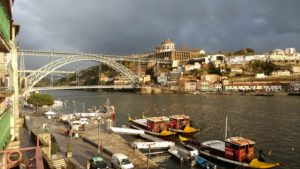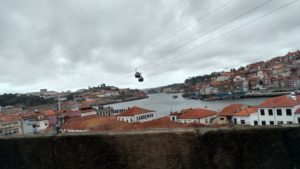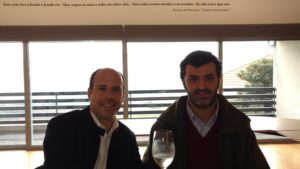I began my Portuguese wine experience in Amarante, a municipality in the Porto District, in Northern Portugal. I was met at the Campanha train station by Quinta da Calçada Managing Director Andre Estacio Pinto who drove me to their hotel property, Casa da Calçada, which is located on the Tamega river directly across from the Sau Goncalo Monastery in Amarante and situated midway between Porto and the Douro valley.
The wine cellars of Quinta da Calçada were founded in this location in 1917. A 16th century manor, Casa da Calçada, still has vineyards planted around it – directly in the heart of Amarante. The rest of their vineyards and their production facility is located several kilometers outside the city center. They are one of the regions oldest producers of Vinho Verde, the famous grape varietal which is set to take the world by storm – a delicious, crisp, bright explosion of fun in a glass.
After getting settled in, Andre and I immediately set out for dinner at a local restaurant known for local Portuguese specialties. Over a glass of Calçada Loureiro/Alvarinho we began our dinner of grilled octopus, wild mushrooms, turnip greens, grilled beef, and baby potatoes. Portuguese food is warm and hearty, and filling! Andre and I found out we had a lot in common, and shared many similar philosophies of how to build and grow a business. A pleasant surprise, he informed me that he had a personal guide scheduled to pick me up the next morning and give me a personal tour of Porto, including visits to the famous Port houses of Sandeman’s and Graham’s. To get a good understanding of the Portuguese wine industry, he explained, I had to start in Porto.
The coastal city of Porto, also known as Oporto, is the 2nd largest city in Portugal and is internationally famous for its export of Port Wine. Port wine is made exclusively from grapes grown in the Douro Valley. The grapes are grown and vinified in the Douro, then sent to Porto where the wine is stored and aged in the famous port house cellars that dominate the Vila Nova de Gaia area, before being bottled. Almost 9 million cases of Port per year are exported annually.
Porto is also known as the city of bridges, with its most famous being designed by Gustave Eiffel, of Eiffel Tower fame, and completed in 1886. The historic center of Porto was designated a Unesco world heritage site in 1996 and claims many beautiful Romanesque buildings and tile-adorned facades.
There are many port styles produced, but simplistically, Port wines can generically be separated into 4 main categories: Blanco, Ruby, Vintage, and Tawny. All are made using the same method, where the fermentation process is stopped by the addition of a neutral grape spirit (77% alcohol), and which creates a fortified wine that ranges from 19-22% alcohol. Ruby and Blanco ports are stored in large barriques, often made of concrete or stainless steel that prevent oxidative aging and therefore produce wines with bright fruit characteristics and bright color. Tawny and vintage Ports are aged in traditional oak barrels, exposing the wine to gradual oxidation – resulting in wine of a golden-brown color and exuding flavor characteristics of almonds, honey, and caramel. While hundreds of grape varietals are sanctioned to be used in the production of port, Touriga Nacional is the most desirable, but it’s low yields are problematic for producers, requiring the inclusion of many different Portuguese varietals..
While Port wines will rightfully forever be identified with the region, it is the table wines that are generating all the recent attention. Indeed, red and white table wines have only been produced for export within the past 15 years, and the world is beginning to discover the incredible quality, and value, that these wines offer. It is exciting to witness the emergence of such a “new” wine region. Portuguese winemakers are not competing amongst themselves, rather they are competing for the hearts of consumers against the wine regions of Chile, Spain, Italy, California and others as they grow in prestige and notoriety.
After spending the day in Porto, I was ready to learn about the history and the wines of Calçada and the Vinho Verde region. António do Lago Cerqueira was born into the palace which became Casa da Calçada in 1880 and he became a politician in the First Republic. Ultimately exiled to France, Lago Cerqueira studied wine production and learned the latest sowing techniques for vineyards. When he returned to Amarante, Lago Cerqueira applied his knowledge of wine production to the vineyards that surround the Casa da Calçada and over time the vineyards flourished. Lago Cerqueira became one of the key wine producers of the Vinho Verde region and his “modern” approach to wine making was soon copied throughout Portugal. Even to this day the vineyards that Lago Cerqueira planted (the oldest in the Vinho Verde region) are still well maintained and the old vines are producing fruit of an exceptional quality.
Calçada winemaker João Cabral Almeida produces wines which cater to all budgets and there is no compromise on the quality. The vines grown are typical of the Vinho Verde region and include the classic varieties Alvarinho, Arinto, Azal, Loureiro and Vinhão. The emphasis is, of course, on white wines, though they also produce fantastic rosé wines and even a red wine in the Lago Cerqueira range. The Lago Cerqueira range offers wines that are exceptional value for money and include a white (Vinho Verde, Rosé and Douro red).
Next, off to the Douro Valley!
Comments are closed







